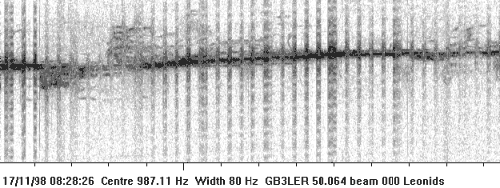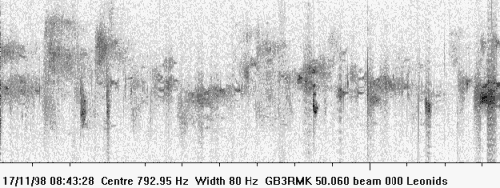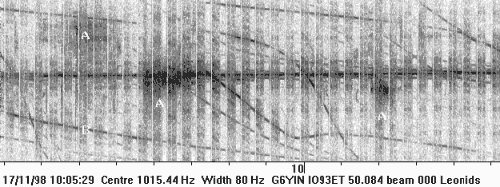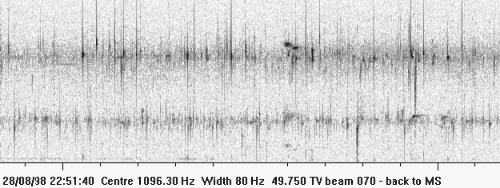during the Leonids meteor shower
on 17th November 1998
Graham Kimball, G3TCT
Issue 60 Six News, February 1999
Six metre signals during the Leonids shower were received here (IO91TG) from a wide area of Europe. Among the stations heard and worked were SM5HJZ, S59F, IW1DIM plus EH, DL and HB, and short skip or backscatter signals from G, GM and PA. The signals were notable for their consistency and (mostly) a lack of MS pings, so that normal ssb procedure was possible. Most of the time it was difficult to distinguish the event from a widespread Es opening. Signals were present from start of operation (17th Nov 0715z) for several hours. I took the opportunity to analyse the Doppler spectrum1 of some of the beacon signals and record the results, using the Motorola 56002 DSP2. I noted that both GB3RMK and GB3LER were good signals, both 559-599.

The dopplergrams show time markers at one minute intervals, and a total scan width of 80Hz. GB3LER was a very strong signal throughout, and the characteristic keying pattern can be clearly seen, spreading the spectrum across nearly the full bandwidth. The beacon sends carrier, followed by its call sign, and every fifth time it also sends its locator. A slow drift in the centre frequency is visible, probably due to receiver and/or transmitter drift. The dopplergram starts on the left with about one minute of steady signal, and there then appears a "smudge" caused by rapid flutter fading, spreading the signal LF of the centre frequency. Two minutes later a similar effect HF of the centre appears. There is a period in the middle of the trace when four distinct frequencies can be observed, one 2Hz low of the centre frequency, one 4Hz high and one 8Hz high. The signal from GB3RMK, although sounding like conventional Es, revealed a quite different spectrum. A much higher fading rate is evident, spreading the spectrum and making the centre frequency difficult to locate. Comparing the two dopplergrams, the frequency spreads are shown in the table:
| Frequency spread | Average | Max. |
| GB3LER | ~ 5Hz | 21Hz |
| GB3RMK | ~ 20Hz | 57Hz |
The third dopplergram shows reception of G6YIN (in beacon mode) in IO93ET (288km), with a variety of modes evident. The keying produces a spectrum spread over 10Hz or so, followed by carrier and then a break about every 24 seconds which can be clearly seen throughout the image.
The central line is the direct tropospheric signal. The Leonid meteor reflections can be seen particularly well at the three points marked "A". The reflected signal is again very diffuse in frequency, since it is fading rapidly. It was difficult to be sure at the time whether the propagation was forward scatter or back scatter. The signal did seem to peak in about the right direction, but this could have been the tropospheric component.
The other feature of note is the aircraft reflections, for example that at "B".
Discussion
When a meteor enters the atmosphere, it heats up and causes the surrounding gases to be ionised. The ionised gases form a trail behind the meteor and the trail then drifts at the local wind speed. The observed Doppler shifts thus represent the E-layer wind speed, taking into account the geometry of the reflection point relative to the signal path. However, the reflected signal fluctuates rapidly due to a number of factors - the variation with time of the ionisation, the variation in the trail geometry relative to the signal path, and the combination of signals from different reflection points with different Doppler shifts. So the result is both a centre frequency and a fading spectrum that varies with time.

The effects that can be seen during the Leonids are quite different from normal MS propagation. Compare them with the plot showing reception earlier in the year of two 49.75 TV carriers about 30Hz apart. Discrete pings are evident throughout the trace, with only a very weak background scatter signal. Despite the much higher power used by the TV, the MS signal is not continuous. The continuity of the signals during the Leonids by contrast shows that much higher quantities of material are entering the earth’s atmosphere, perhaps by a factor of 100 or more.

Why is the spectrum of GB3RMK so different from that of GB3LER? The paths from IO91 are similar - the heading difference is only 15 degrees. The path lengths are about 1010km (LER) and 756km (RMK). We know that the ionisation intensity needed to sustain propagation is a function of the path length, so that shorter skip paths require higher ionisation. If the MUF is below that needed for the direct RMK path, the signal will not be reflected but will be scattered from a (large) number of individual trails, leading to a high fluctuation rate. If there is a tendency for the scattering centres to be further off the direct path, this will also lead to more variation in the Doppler shifts. We can contrast this with the Lerwick path where we could speculate that the MUF is above 50 MHz. In this case the ionisation will appear as a flat-bottomed layer, and the signal will be reflected rather than scattered. However a reasonable question might be "why doesn’t GB3LER exhibit similar scattering to RMK, in addition to the reflection?" Maybe someone has a better model that can explain this.

In conclusion
Doppler DSP provides an interesting insight into propagation at 50MHz and a new way of deciding which propagation modes are present or even to recognise several simultaneous modes. To make more use of this, there is a need for more stable beacon signals, and to ensure that there is an adequate period (at least 12 seconds) of unbroken carrier each cycle to allow narrow band Doppler processing.
Acknowledgements
I am indebted to Peter Martinez G3PLX for providing the Doppler analysis software, and for his helpful comments on the results.
References
1. Using Doppler DSP to study HF propagation, P Martinez G3PLX, RadCom
May 1998
2. Equipment used: 5-ele yagi at 35ft agl, ICOM 575 rig, and the Motorola
56002EVM DSP using G3PLX software.
*39 Downs Way, Great Bookham, Surrey, KT23 4BL, UK
© Copyright Graham Kimbell 1999